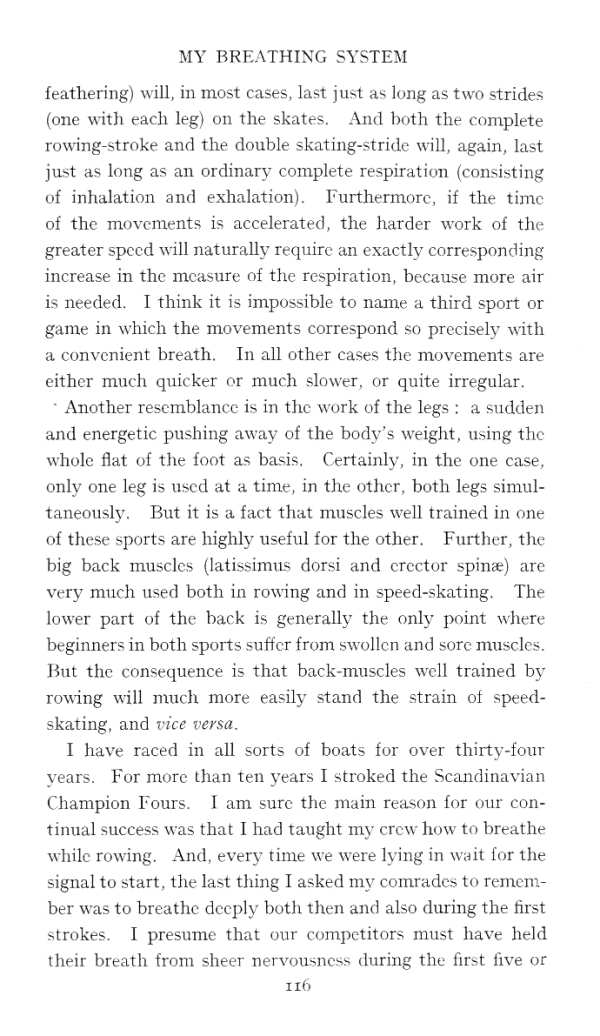69626 mbs 116

MY BRF.ATHING SYSTEM
featliering) will, in most cases, last j ust as long as two strides (one with each leg) on the skates. And both tlie complete rowing-stroke and the double skating-stride will, again, last just as long as an ordinary complete respiration (consisting of inhalation and exhalation). Furthermorc, if the timc of the movcments is aćcelerated, the harder work of the greater specd will naturally reąuire an exactlv corresponding increase in the mcasure of the respiration, beeause moro air is needed. I think it is impossible to name a third spon or gamę in whicli the movements correspond so preciselr with a convenient breath. In all other cases the movements are eithcr much ąuicker or much slower, or quite irregular.
Another resemblance is in the work of the legs : a sudden and energetic pushing away of the bodv's weight, using the wholc flat of the foot as basis, Certainly, in the one case, only one leg is uscd at a time, in the other, both legs simul-taneously. But it is a fart that muscles well trained in one of these sports are highly useful for the other. Further, the big back muscles (latissimus dorsi and crcctor spina?) are very much used both in rowing and in speed-skating. The lower part of the back is generally the only point where beginners in both sports suffer from swollcn and sore muscles. But the consetjuence is that back-muscles well trained by rowing will much morę easily stand the strain of speed-skating, and vice vcrsa.
I have raced in all sorts of boats for over thirty-four years. For morę than ten years I stroked the Scandinavian Champion Fours. I am surę the main reason for our con-tinual success was that I had taught my crew how to breathe whilc rowing. And, every time we were lying in wait for the signal to start, the last thing I asked my comrades to reinem-ber was to breathe dccply both then and also during the first strokes. I presume that our competitors must have held their breath from sheer nemmsncss during the first five or
116
Wyszukiwarka
Podobne podstrony:
mbs 048 MY BRF.ATHING SYSTEM Dr. J. F. Halls Daily on the Diaphragm. For thirtcen years I)r. Hall-;
26761 mbs 018 MY BKI.ATHING SYSTEM The Importance of Physical Exercise immediately before Deep-Breat
mbs 096 MY BRF.ATHIYG SYSTEM EXERCISE No. 6. Alternate one-sided deep exhalation during side-bending
mbs 034 MY BRKATHI.YG SYSTEM other in a detinite space of time, and on the grcater or shorter durati
mbs 065 MY BREATH ING SYSTEM exhalation comprise, each of them. two abdominal move-ments—four in all
mbs 071 MY BRKAI HING SYSTEM How the Heart is often Injured. It inay be useful to discuss this matte
mbs 025 MY HRKATlUNd SYSTKM vapour, bocornes transfornied in dry vvc.itber into bard crusts. i heref
więcej podobnych podstron